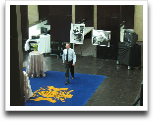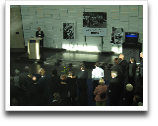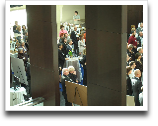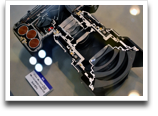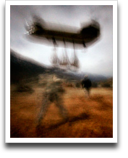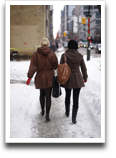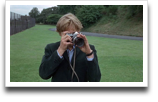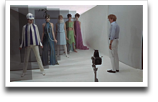The primary source
for Google
Earth's satellite imagery is DigitalGlobe's satellite orbiting
300 miles up, with a 13 inch CCD, 30,000 pixels across (I assume a
1 pixel wide slit, but the article isn't clear), with a 9,144mm
(equivalent length) lens with a fixed aperture of f/14.7.

This journal documents my experiences with a Canon 50D, my first DSLR camera, purchased on Oct. 16, 2008. It has some of my photographs taken with the 50D, comments about the camera's usability and suggestions for improvement. It also has links to photography-related sites which I found interesting.
DigitalGlobe Camera
satellite photography
More Camera Settings and Wishes
settings safety flash
Based on Ken Rockwell's suggestion, I enabled Safety Shift (C.FnI-6) which allows the camera to override the shutter speed so the photo is exposed correctly for the given aperture (no more blinking shutter speeds in the view-finder).
He also suggested setting the Shutter Curtain Sync to the Second Curtain so the flash fires at the end of the exposure given blur trails behind the subject (visually this makes more sense if the subject is moving) rather than at the start of the exposure (First Curtain) which gives blur trails in front of the subject.
Since I don't use flash, I have not yet set this.
Camera Wish: Backlit Buttons
Given how popular extra button-pressing is with Canon engineers, I wish the camera had backlit buttons so I can see what I'm pressing in the dark. A backlit exposure-setting top-dial would be nice too. Since the camera has a built-in light meter, it could be tied-in so the backlight turned on as the ambient light dropped.

Winter Macro
photos
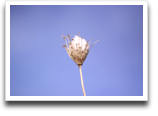 |
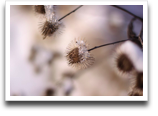 |
|
I notice slight vignetting in the corners of the first photo (I like the effect, though). The out-of-focus elements are due to the high winds. Shooting in Aperture Priority at f/1.4 [2 of 10] |
||
Last month, on the morning after a heavy snowfall, I left early for work and took some photos in an empty field along the way. Many of the photos were badly blurred due to the high winds. I use both these photos for my desktop backgrounds. A couple of other photos have too much white (snow in the background) which make them too bright and unsuitable for desktops.
I would not argue if you said that it seems I bought this camera just so I could have nice desktop backgrounds.

Neutral Density Graduated Filters
technique
Using a neutral density graduated filters to do in-camera HDR photography is the next best thing to doing HDR photography with additional computer based image processing.
The filters are designed to underexpose the sky and over-expose the landscape thus giving a balanced exposure across two widely differing exposures.
I stumbled across graduate filters while searching for tips on long exposure photography. But I didn't expect to stumble on nightscape photography, which involves extremely long exposures to make photographs taken at night, look like they were taken in daylight; the opposite of the day for night trick often used in movies.
Additional setting for Canon cameras taking long exposures (C.FnII Long Exposure Noise Reduction set to Auto (applied to exposures over 1s)).

The Blackstar Collection
photos
Continuing my search for long exposure photography tips, I stumbled upon an article about the Blackstar collection that was recently donated to Ryerson University. Then I remembered that I had snapped a few photographs of the unveiling of the collection on April 14, 2005, in the atrium in the building where I work. These photos were taken with a Canon S60.
At the time, I had no idea what this collection was about nor its importance and I couldn't appreciate the efforts made by the photographers taking these pictures. I also no idea that one day, I would be posting these pictures in my photography journal (or that I would even have a photography journal for that matter).

National Portrait Gallery
photos
An exhibition
of contemporary portraiture, at the National Portrait Gallery,
taken by some of the best portrait photographers. Unfortunately,
the resolution of the online photos is rather poor.

Choices
technology philosophy
When making your choice in life, do not neglect
to live.
—Samuel Johnson
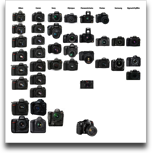
David sent me a post illustrating an explosion in the choice of dSLR camera models available in the last six months (aside: given the economic downturn, I predict that prices will drop— the 50D can be had for $150 less than I paid in October— and many of the models pictured, will vanish by this time next year).
Choice is always good; the problem lies in the deciding. One could argue that with only one choice, decisions are easier. However, there are always two choices— you can always decide not to choose.
It doesn't matter which camera you pick as long as you pick one that does what you want. If you don't know what you want it to do, then no amount of choice is going to help.
Ultimately, remember why you bought the camera— to take pictures; to have fun.

Youtube Lighting Tutorials
technique
The first rule of photography: lighting is everything.
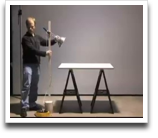
I found a series of Youtube tutorials about indoor lighting by ProPhotoLife.com— everything from table-top objects (product photography) to portraits.
Though the sound level needs to be adjusted up and down between each episode, the episodes themselves do an excellent job illustrating how lighting alone can change the look of the image.
Episode 2 of the series, DIY Photo Studio Product Lighting, shows that studio lighting equipment (stands, lights and tables) can be purchased in hardware stores instead of photography stores.

SLR and Rangefinder Cameras
technology
A
good article
that explains the differences between cameras that use SLR technology
and Rangefinder technology.

Flickr Stock Photos
business
According to a
TechCrunch article,
Flickr was planning to launch a stock photo store where users could buy and
sell photographs. Instead, that plan was shelved and a deal with Getty Images
got a few (good) Flickr photographers invited to post their photos in the
Getty stock pool.

Portfolio: Josef Koudelka
photographer
I was surprised to learn that Koudelka was educated as an engineer. His photographs do not betray that training. He has absolutely perfect composition.
He is most famous for the award-winning photographs of the Soviet
invasion of Czechoslovakia, which were anonymously published after being
smuggled out of Prague.

Canon 5D for Official Portrait by Pete Souza
photo photographer
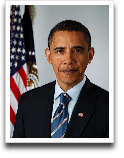
Obama's official portrait was taken with a Canon 5D by Pete Souza (sounds Portuguese). It is the first official presidential portrait taken with a digital camera. According to the EXIF data in the file provided it was exposed at f/10 with a shutter speed of 1/125s at 100 ISO.
Update Thu Jan 15 15:24:51 2009: Looking through Souza's website, I found a photograph of Reagan at the Challenger memorial service in the "Portrait of a President" gallery. It is easy to pick the secret service agents in the crowd— they are the ones without their heads bowed (I counted about 15, including two female).
I love his framing. He has a great eye for photographing people (see
the Wrigley Field gallery), more so than landscapes (Kosovo, Katrina, Kabul).

Winter Spider
photo
Your stairway lies on the whispering wind.
—Stairway to Heaven
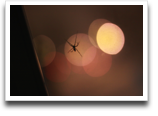 |
I was going some night photography on Christmas eve and I noticed a spider scurrying across the window. Taken at the minimum focus distance at f/1.4, 1600 ISO, 1/100s. [ 1 of 2] |
The spider moved much too fast for me to be able to focus and shoot and
I could only shoot it while it was at eye level. The nice bokeh is from the
traffic lights at the end of the block. I suppose I should also wash my windows.

Portfolio: Todd Selby
photographer
Todd Selby photographs interesting people and their creative spaces.
I have never seen people photographed and cropped like this album— very original. Only one computer in all the photographs (and of course, it's a Mac).
And I've just fallen in love with Aya
Kanai who
is profiled
along with her father. I am willing to forgive her for using a Nikon.

PolarOde
history polaroid
Polaroids, reflecting our imperfectability, reminded
us by contrast of our humanity.
—Michael Kimmelman
Michael Kimmelman remembers the Polaroid camera. "During the early 1970s, to help introduce its product, Polaroid doled out SX-70s with unlimited film to a few prominent photographers [including Walker Evans]."
I found an unread NY Times "Week in Review" from Dec. 28, 2008, where I discovered this piece. All I remember from this era is Marianne Hartley and James Garner doing TV ads for Polaroid cameras. I wasn't much interested in photography (instant or otherwise) at the time. Though I remember taking film to be developed at the Fotomat drive-through kiosk at a local strip-mall.
Related post: Polaroid Land Camera
Ad.

My First Camera
hardware nostalgia
When I was a child I caught a fleeting glimpse,
Out of the corner of my eye.
I turned to look but it was gone.
I cannot put my finger on it now.
The child is grown, the dream is gone.
—Comfortably Numb
Trips to the Fotomat kiosk, mentioned in the previous post, reminded me that I did have a camera of my own. I spent about thirty minutes Googling for pictures and the name of my first camera; all I remembered was that it was an Argus. The problem searching for "argus" alone, was that Argus was famous for making 35mm cameras, which were discontinued around 1969.
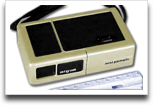
I finally found a site (keywords were: "argus instamatic 16mm cartridge camera"; 3rd result) which has a picture of a camera which looks like the camera I had (but it may or may not be the right model)— the Mini Palmatic. From what I remember, the body was gold brushed metal and the flash was external consisting of a row of 6 bulbs which were used one at a time, but you had to flip the holder every time you used a flash. The film was a 110 cartridge (Kodak, naturally) and to advance the film you had to pull the camera apart along the horizontal plane and push it back together. I mostly took pictures when the class went on school-trips (the science centre, the Metro Zoo, the ROM) and I remember thinking why all my indoor pictures never developed (I didn't use flash because the bulbs were expensive) even though the image appeared on the negative.

Big-Three Shootout
hardware
Luminous Landscapes has a sensor noise comparison of the Sony A900, the Canon 5DMkII and the Nikon D3x, at various ISO settings.
The verdict: Canon 5DMkII wins, with the best price/performance ratio.
I was surprised at how little noise was displayed in the beige-toned card next to the dark brown card, across all three cameras.
I can't imagine any professional photographer using Sony SLR cameras
unless they are playing photographers in Spiderman movies.

Portfolio: Lou Mora
photos
Really beautiful
portrait photography (requires
Flash) by Lou Mora. All his outdoor photography is done in the Golden
Hour (it looks a bit repetitive in the portfolio; I would have preferred
to see some night photos). His indoor photography is remarkable for
being so crystal clear. My guess is that he shoots Canon.

Inauguration Seen From Space
technology
An unique prespective of the inauguration— satellite photographs.

Carl Zeiss Lenses
hardware lenses
Carl Zeiss makes lenses for various camera including Canon. A 21mm lens was just announced last fall.
The lenses are said to be better, not only in manufacturer but also in optical quality, than those of their respective camera makers. A larger variety of lenses are available with Nikon F mounts than Canon EF mounts, but all the Nikon lenses can be used on Canon cameras with the appropriate adapter.
One major downside to the Zeiss lenses is that they do not auto-focus. This is a great disadvantage for me because I do not wear my glasses when I shoot and thus have to rely on the camera to do my focusing. Using Live View 10x zoom would help me to focus accurately but only when either I use a tripod or an image stabilized lens; otherwise the image shakes too much when handheld.

My Canon 50D Review
review
I have combined my journal entries to create
a page with a comprehensive review of the Canon EOS 50D. It including all the custom settings I have made and also a list of my usability complaints. It is a work in progress and there will be addendums as I continue to use the camera.

Nikon D1.5
technology
A Nikon D3 sliced neatly in half, revealing the inner workings.
Blurry Photos
photo
I used to have a rule that, at minimum, a photograph had to be in focus for it to be a keeper. Until I saw the cover photograph in last Sunday's NY Times Week in Review— a blurry photograph of a Chinook helicopter hovering near the ground, with some figures running in the foreground.
In the actual paper, the photograph takes up half the page and looks quite amazing. It succintly expresses the gut-churning thundering of a military helicopter at close proximity.

Prices
hardware
Looking through the 100th Anniversary Henrys flyer I notice that the 50D is now available for CAD$1299, but more surprising is that the 17-40mmL lens which was $729 in November is now $799 (with the claim that this price is $100 off the list price).
Update Sat Jan 31 00:37:00 2009: Stumbled on
an article
about lens prices. I am currently in the market for a 24mm (prime)
lens looking at prices for the 24/2.8, Downtown Camera has it for
$449.00; it's $499 at Henrys and $489 at Vistek (special order).

Canon EF 24mm f/1.4 L II USM Lens Review
review
The 24mm f/1.4 L lens review is finally out (the 2008 date is a typo); it actually appeared two days ago. To summarize, it is Canon's best 24mm lens (sharpest at f/2.8).
Update Sat Jan 31 00:53:30 2009: Bob Atkins comments on various 24mm lenses. Summary of his verdict: "The faster 24/1.4L is 4x the price of the 24/2.8... but I doubt most users would see much improvement over the 24/2.8 when stopped down to f8 or smaller apertures for landscape work. The EF 24-105/4L IS USM is also a good choice... The downside of the zoom is the cost (close to $1000) and the significantly larger size and weight than the 24/2.8."

Photo Tip: Lightning
photo
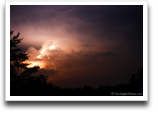
I came across a tip on photographing lightning in a caption to one
of
the photographs
in the sample album:

When it is dark out, use a remote release and bulb mode to open the shutter until lightning flashes. Use manual mode and set your aperture and ISO based on the brightness of the sky and distance to the storm. Prefocus the lens (on a distant street/night light?) and turn off autofocus.
Winter Fashions
photo fashion
Outdoor Sports
philosophy
I am in Paris!
—Blowup
I was chatting with a faculty memeber a few days ago on the subject of hobbies. He is an avid snowboarder (suprising because he is close to retirement age) who decided on the sport after watching some snowboarders while his daughter was learning to ski— "it looked pretty easy and fun" (he already knew how to ski). He asked whether I was participated in any outdoor sports and I said yes, I was rather fond of landscape photography as an outdoor sport.
Most of us engage in hobbies because we see something that looks "pretty easy and fun" and think that we too, can do that. What we don't realize when we watch these athletes, is the five years they spent practicing their skills. The same theory applies to photography— most people who decide on photography as a hobby (not people who take pictures when vacationing) probably looked at photographs in a magazine and thought it looked pretty easy. But after buying a camera they wonder why their photographs don't quite come out like the ones they saw in the magazine. They think the problem is with the equipment and proceed to buy an even more expensive camera to no avail. I know people who have used cameras for an entire year without having read the manual (I have read mine three times in the three months I have had the camera and still do knot know how to do certain obscure functions (bulb mode for example).
I had earlier stated that I considered Flickr as the Slashdot of photography, but I have come to re-consider that statement in light of a recent discussion on the #photogeeks channel on freenode.net. Flickr is the Slashdot of photography insofar as incompetant people comment on various topics without having any authority to do so but speaking in a voice of authority. There is a difference between giving an opinion and giving advice.
The biggest difference between Flickr and Slashdot comments is that there are no flame-wars on Flickr. Generally speaking, there are neither negative comments nor negative (constructive or otherwise) criticisms on Flickr. This attitude encourages incompetent photographers to continue doing things they have no aptitude for. On the other extreme is a photograph that (deservedly) receives an avalanche of accolades but gives the photographer the false impression that they are good, when the photograph was actually a creatively fortunate mistake.
The first year I started photographing with my S30, I took about three thousand photographs and I would have considered only one of them good enough to exhibit (and to make it worse, that photograph was a lucky accident).

